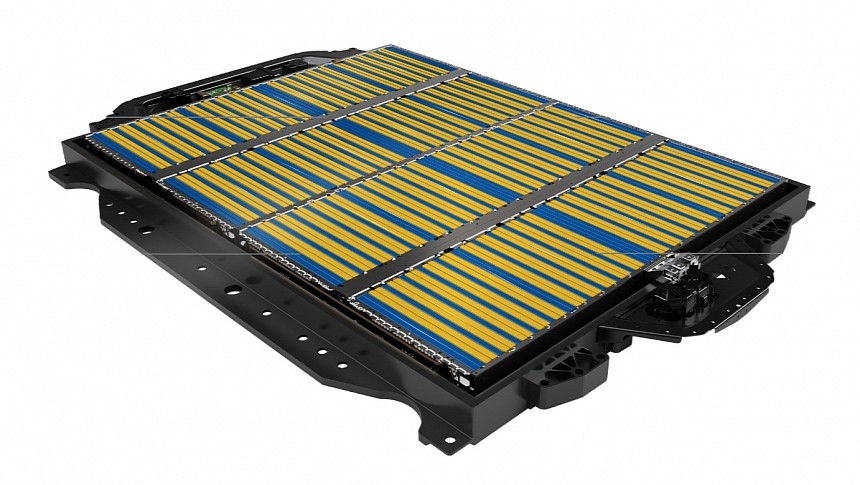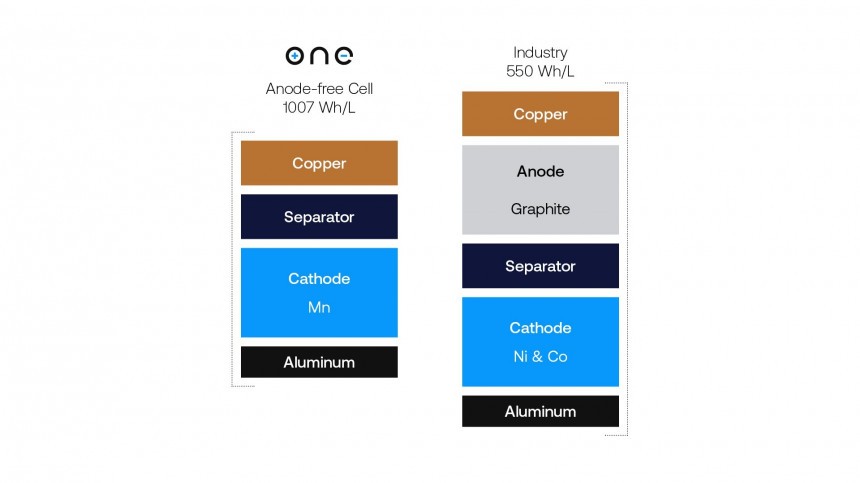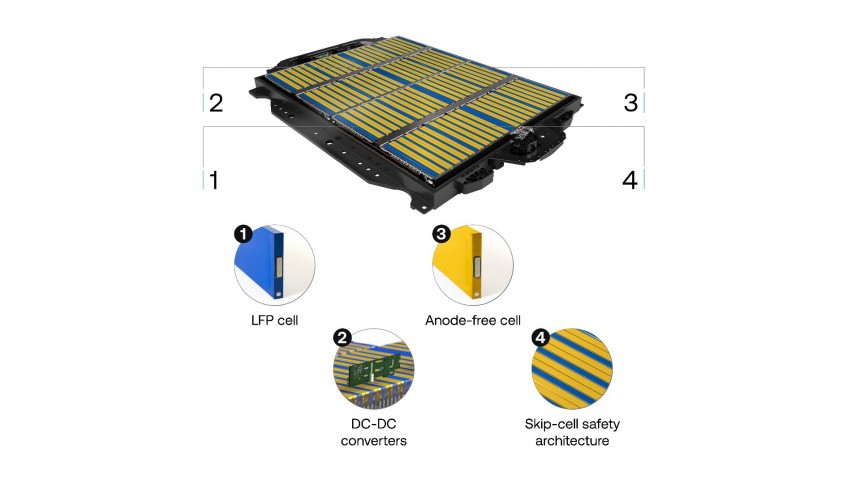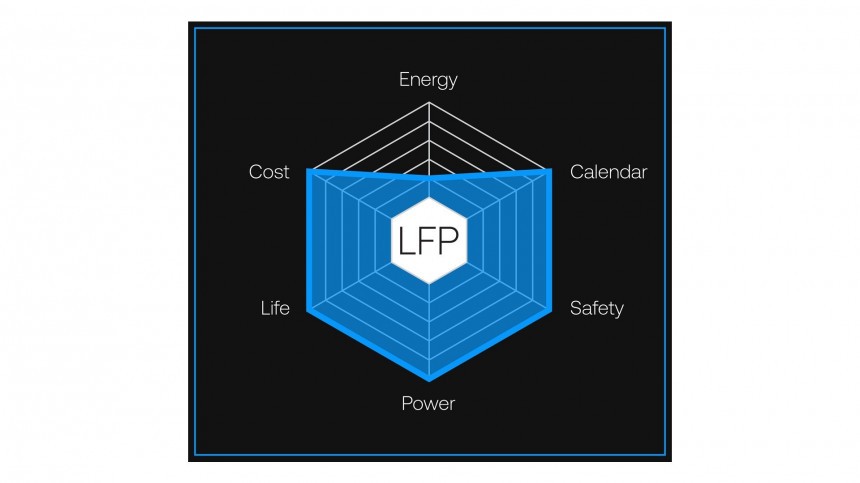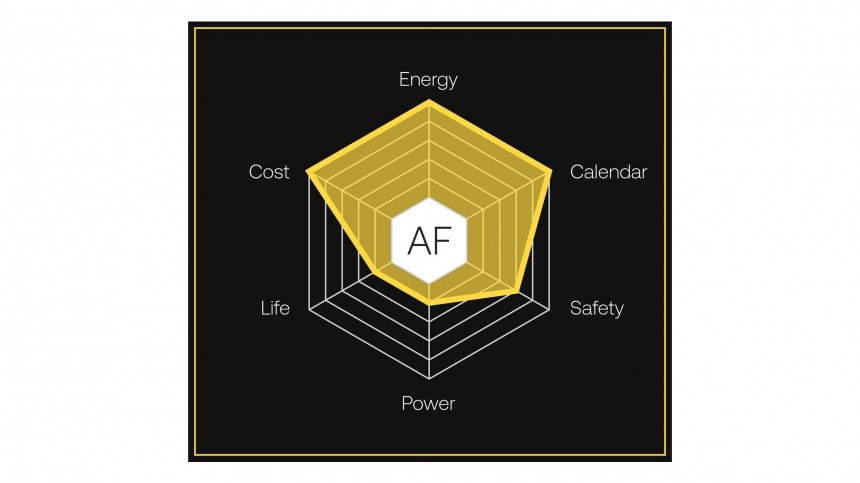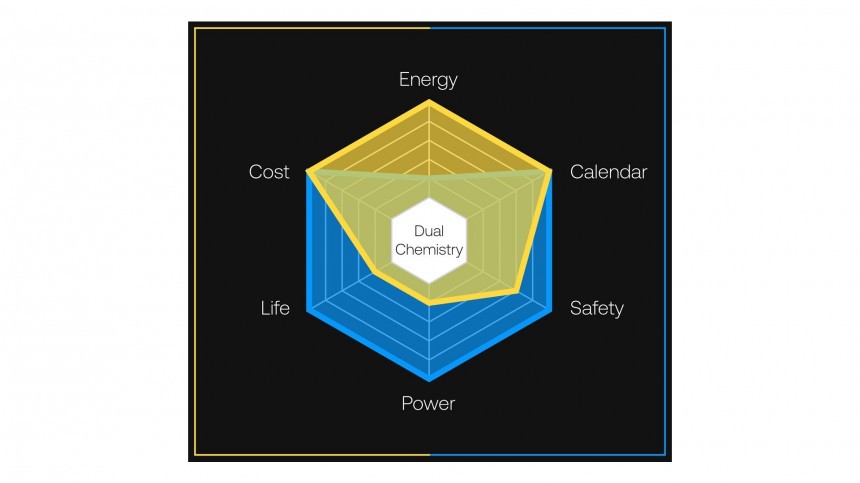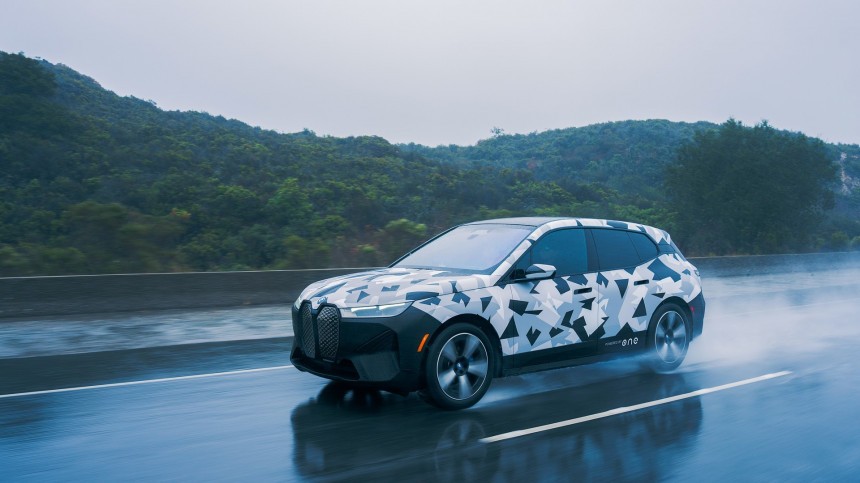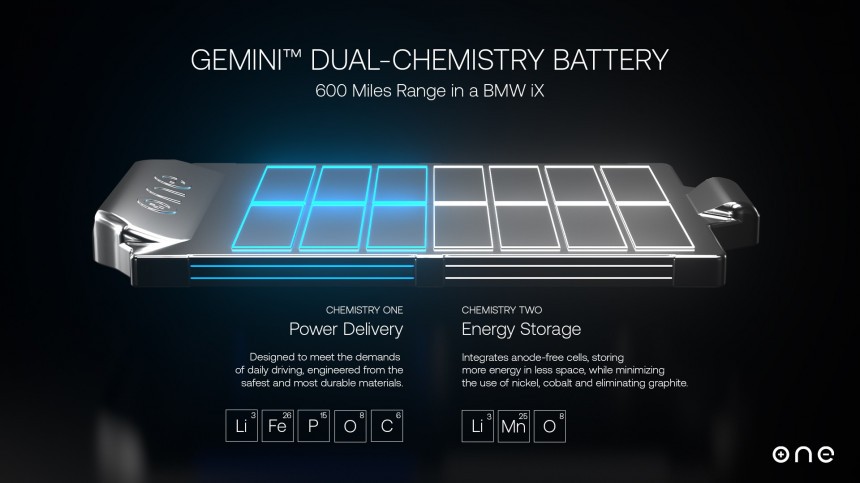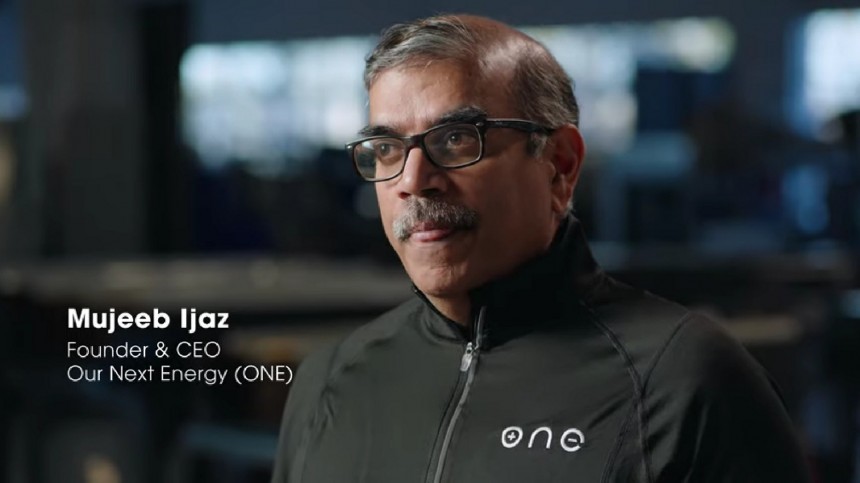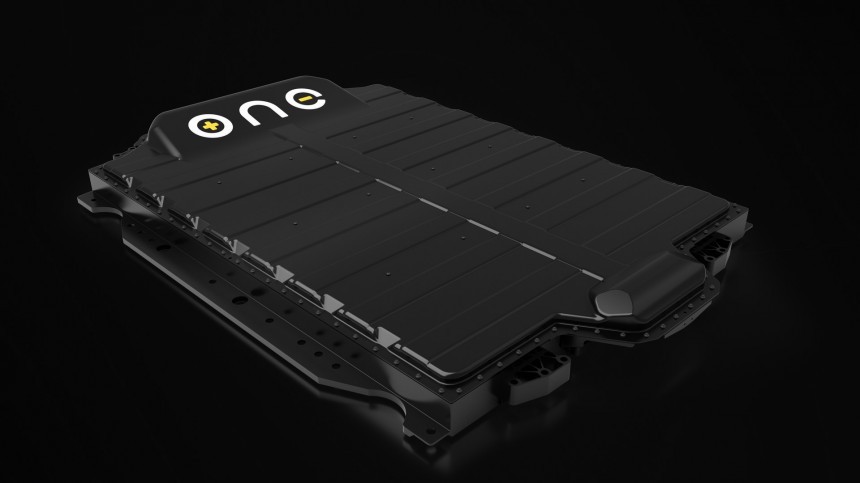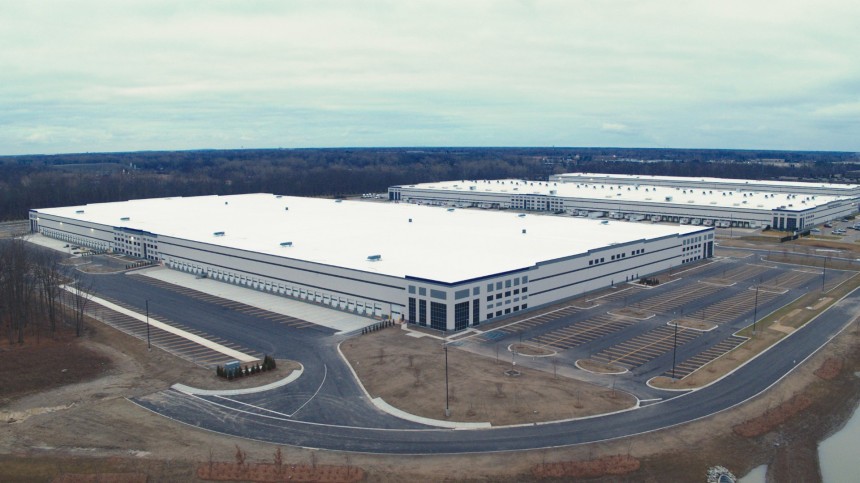I have been following Our Next Energy (ONE) as closely as possible after the company achieved something extraordinary. It made a Model S equipped with its Gemini battery pack run 752 miles (1,210 kilometers) on a single full charge. This component was defined as a hybrid because it mixed two kinds of cells, but what ONE recently disclosed about it shows it deserves the classification for way more than that.
In September 2022, a Reuters story led me to believe that the Gemini battery pack would have LFP cells mixed with NMC batteries because they had "cathodes made of nickel, cobalt, and manganese." This new story works to correct this mistake: that was a temporary arrangement. ONE will use a different chemistry in the Gemini, but what deserves more attention is the interesting structure it conceived to have it.
ONE calls it a "skip-cell safety architecture," meaning that lithium iron phosphate (LFP) cells are mixed with the startup's new anode-free batteries. The company confirmed to Motortrend that they are lithium metal cells. Honestly, that was the only possible explanation for a cell without an anode. Lithium ions plate on the copper foil on the other side of the separator during the discharge process and migrate back to the cathode when the battery is charged. QuantumScape's solid-state cell will work in the same way, but ONE did not say its new anode-free battery presents a solid electrolyte. Nonetheless, it must have a special separator. If that is confirmed, it should fit among semi-solid-state cells.
In the images released by ONE, the Gemini battery pack apparently has eight modules, with two prismatic LFP cells in each extreme and also in the middle. That would explain why the pictures show four blue LFP batteries in the middle of the battery pack: the two battery modules in each of its four rows meet. The yellow anode-free prismatic cells are always grouped in pairs and never on the extremes of the battery modules.
Another possible explanation is that ONE has just four modules and decided to install four LFP cells in the middle of each module because it is a more sensitive area. If we have eight modules, each one has 14 LFP cells and 20 lithium-metal batteries. Should they be only four, each module has 40 anode-free cells and 28 LFP batteries. Regardless of the true number of modules, the Gemini battery pack pictured in the images presents 112 LFP cells and 160 lithium metal batteries, respectively, with a 41.2%/58.8% proportion.
Calling this arrangement a "skip-cell safety architecture" suggests it was conceived to minimize thermal runaway events with the anode-free cells, which are lighter and also hold more energy than LFP batteries. Lithium metal cells are also more prone to dendrites, needle-like structures that perforate the separator, connect the anode and the cathode, and cause short circuits. ONE confirms that by stating it "sharply reduces the risk of thermal runaway." If one lithium metal cell starts a fire, LFP batteries could create a barrier that restricts the damage. Whether this is as effective as ONE says it is, that's certainly a good idea not to have all high-energy-density cells together should any of them present issues.
Perhaps the most critical components in the Gemini battery pack are the DC-to-DC converters. In most BEVs, their role is to keep the 12V battery charged, as an alternator does in combustion-engined vehicles. However, they seem to play a more crucial role in ONE's hybrid component. The battery startup said that the DC-to-DC converters move energy between the LFP cells and anode-free batteries seamlessly. There are several purposes for that, but ONE disclosed the most important one.
The LFP cells will provide around 150 miles (241.4 km) of range, which is more than enough for the daily driving needs of most drivers. According to the startup, Gemini "switches to the anode-free cell, using it to charge the LFP cell" after 150 miles. Why not use the lithium metal batteries directly, especially considering there are losses with DC-toDC converters? Simple: to preserve them as much as possible.
If the anode-free cells can charge and discharge at a slower rate than LFP, ONE can ensure they will not be submitted to stress, which could eventually make them develop dendrites more easily. It would be interesting to have the fast charging data for the Gemini battery pack. Still, I suspect that these occasions will invert the process the startup described: the LFP cells will take the fast-charge punch and slowly let the lithium metal batteries recover energy. In a way, that's precisely the principle a hybrid car follows. Instead of saving the most precious cells as the Gemini battery pack is designed to do, they save fuel.
In hard-acceleration situations – when a combustion engine burns more fuel – the electric motor acts with its instant torque until the desired speed. At that point, the combustion engine takes over just to keep the car moving, generally at the most favorable rotation for fuel consumption. When the car brakes – a situation of energy loss – the electric motor acts like a generator. By harvesting the energy that would be lost as heat and friction in the brakes, it can use this electricity when the driver presses the gas pedal more vigorously.
The lithium metal cells can keep enough juice for 450 additional miles. According to ONE, the Gemini battery pack achieves over 600 miles with a capacity of 185 kWh. Anyone familiar with EVs will say there is nothing remarkable about that long range with such a massive component. Indeed.
The Lucid Air has an EPA range of 520 miles with a 118-kWh battery pack. If it could keep the same efficiency equipped with the Gemini accumulator (4.4 mi/kWh), it would be able to run 814 miles instead of 600 miles. But how heavy is the Gemini battery pack? ONE never talked about that – and it should. I suspect that it is its greatest asset.
The vehicle that ONE will use to present the Gemini battery pack is the BMW iX. It was supposed to be presented by the end of 2022, but it wasn't. Although ONE has yet to update us on when this prototype should be officially introduced, it has pictures on its website showing an iX with the startup's logo on the sides. It may be the case that ONE created it for BMW's eyes only.
Despite that, this BEV's high-voltage accumulator can have up to 105.2 kWh. Supposing ONE did not modify the car and made a larger niche in it for the battery pack, these 185 kWh were squeezed into the same space available for its 105.2-kWh battery pack, possibly with the same weight.
I did an exercise using the proportion of LFP and anode-free cells that the images revealed. Supposing the iX pack was made of LFP batteries and could store 105.2 kWh, a 41.2% share would correspond to 43.3 kWh. The other 58.8%part of the battery pack would hold the lithium metal cells with more energy density. That space in the 105.2-kWh battery pack is equivalent to 61.9 kWh of standard cells. Suppose ONE's anode-free batteries could provide double the energy density. Instead of 61.9 kWh, we would have 123.8 kWh. In total, this hypothetical Gemini unit could deliver 167.1 kWh, less than the 185 kWh ONE said it had in the iX.
This exercise gets even more challenging when you remember the production version of this BMW uses NMC cells. That means they have a higher energy density than the LFP batteries ONE uses. In other words, 41.2% of the space in the battery pack would deliver less than 43.3 kWh. If it has 185 kWh, most of that energy comes from the lithium metal cells.
The explanation may be that the startup improved the energy density of the whole pack, not only its new anode-free cells. The way to do that is by fitting more batteries into the same space. Another possibility is that the lithium metal cells are actually more powerful than Mujeeb Ijaz said they were. Ultimately, both could be true.
In a chat with Motortrend, ONE's CEO mentioned that removing the anode and eliminating nickel and cobalt from the batteries made room to double the energy density. What if he was being modest? It seems that was the case if the iX really has 185 kWh.
Manganese is the main component of the anode-free cells, and the company's website gave us some tips on what is in them. According to ONE, they have 20% less lithium, 60% less graphite, 75% less nickel, and 100% less cobalt. That's a slightly different story than when the startup disclosed the battery did not have nickel anymore, which shows the anode-free cell is probably still under development. In September 2022, the company said it allowed a $50-per-kWh cell cost at scale, but that has perhaps changed until now. Curiously, graphite is more used in anodes, so a cell that lacks them should not have the material unless it is used in the cathode. Is that the case with the Gemini battery pack?
ONE's lithium metal cells have a volumetric energy density of 1,007 Wh/l, more than twice as much as what the LFP batteries offer (441 Wh/l). As we usually talk about gravimetric energy density, we can only try to guess what ONE achieved with its new cell. Amprius announced its lithium metal cells offered 504 Wh/kg and over 1,321 Wh/l at 25°C (77ºF). SES said its Apollo battery, which is a lithium-metal, semi-solid-cell, delivers 935 Wh/l and 417 Wh/kg. It will not surprise anyone if the anode-free cells ONE developed provide around 450 Wh/kg.
We'll probably only know more about that in 2024. That's when ONE will open its factory in Van Buren Township, Michigan. Called ONE Circle, the plant will demand an investment of $1.6 billion, which is strange considering it will be located in a leased facility. A good chunk of factory investments goes into building efforts. That probably has to do with all the machines the plant will need to reach an annual production of 20 GWh by the end of 2027. At that point, ONE Circle will have 2,112 workers, which is a precise count. By 2028, the company expects to achieve a 45% reduction in carbon emissions thanks to a circular production process. Circle, circular… You get the point.
Although the factory will open next year, we're yet to learn which will be the first passenger vehicle to have the Gemini battery pack. We also need to know if the company plans to make these components repairable, which is a must for electric cars. The bottom line is that it should pay off to keep checking what this startup is doing: it makes a lot more sense than most other BEV initiatives around.
ONE calls it a "skip-cell safety architecture," meaning that lithium iron phosphate (LFP) cells are mixed with the startup's new anode-free batteries. The company confirmed to Motortrend that they are lithium metal cells. Honestly, that was the only possible explanation for a cell without an anode. Lithium ions plate on the copper foil on the other side of the separator during the discharge process and migrate back to the cathode when the battery is charged. QuantumScape's solid-state cell will work in the same way, but ONE did not say its new anode-free battery presents a solid electrolyte. Nonetheless, it must have a special separator. If that is confirmed, it should fit among semi-solid-state cells.
Another possible explanation is that ONE has just four modules and decided to install four LFP cells in the middle of each module because it is a more sensitive area. If we have eight modules, each one has 14 LFP cells and 20 lithium-metal batteries. Should they be only four, each module has 40 anode-free cells and 28 LFP batteries. Regardless of the true number of modules, the Gemini battery pack pictured in the images presents 112 LFP cells and 160 lithium metal batteries, respectively, with a 41.2%/58.8% proportion.
Perhaps the most critical components in the Gemini battery pack are the DC-to-DC converters. In most BEVs, their role is to keep the 12V battery charged, as an alternator does in combustion-engined vehicles. However, they seem to play a more crucial role in ONE's hybrid component. The battery startup said that the DC-to-DC converters move energy between the LFP cells and anode-free batteries seamlessly. There are several purposes for that, but ONE disclosed the most important one.
If the anode-free cells can charge and discharge at a slower rate than LFP, ONE can ensure they will not be submitted to stress, which could eventually make them develop dendrites more easily. It would be interesting to have the fast charging data for the Gemini battery pack. Still, I suspect that these occasions will invert the process the startup described: the LFP cells will take the fast-charge punch and slowly let the lithium metal batteries recover energy. In a way, that's precisely the principle a hybrid car follows. Instead of saving the most precious cells as the Gemini battery pack is designed to do, they save fuel.
The lithium metal cells can keep enough juice for 450 additional miles. According to ONE, the Gemini battery pack achieves over 600 miles with a capacity of 185 kWh. Anyone familiar with EVs will say there is nothing remarkable about that long range with such a massive component. Indeed.
The vehicle that ONE will use to present the Gemini battery pack is the BMW iX. It was supposed to be presented by the end of 2022, but it wasn't. Although ONE has yet to update us on when this prototype should be officially introduced, it has pictures on its website showing an iX with the startup's logo on the sides. It may be the case that ONE created it for BMW's eyes only.
I did an exercise using the proportion of LFP and anode-free cells that the images revealed. Supposing the iX pack was made of LFP batteries and could store 105.2 kWh, a 41.2% share would correspond to 43.3 kWh. The other 58.8%part of the battery pack would hold the lithium metal cells with more energy density. That space in the 105.2-kWh battery pack is equivalent to 61.9 kWh of standard cells. Suppose ONE's anode-free batteries could provide double the energy density. Instead of 61.9 kWh, we would have 123.8 kWh. In total, this hypothetical Gemini unit could deliver 167.1 kWh, less than the 185 kWh ONE said it had in the iX.
The explanation may be that the startup improved the energy density of the whole pack, not only its new anode-free cells. The way to do that is by fitting more batteries into the same space. Another possibility is that the lithium metal cells are actually more powerful than Mujeeb Ijaz said they were. Ultimately, both could be true.
Manganese is the main component of the anode-free cells, and the company's website gave us some tips on what is in them. According to ONE, they have 20% less lithium, 60% less graphite, 75% less nickel, and 100% less cobalt. That's a slightly different story than when the startup disclosed the battery did not have nickel anymore, which shows the anode-free cell is probably still under development. In September 2022, the company said it allowed a $50-per-kWh cell cost at scale, but that has perhaps changed until now. Curiously, graphite is more used in anodes, so a cell that lacks them should not have the material unless it is used in the cathode. Is that the case with the Gemini battery pack?
We'll probably only know more about that in 2024. That's when ONE will open its factory in Van Buren Township, Michigan. Called ONE Circle, the plant will demand an investment of $1.6 billion, which is strange considering it will be located in a leased facility. A good chunk of factory investments goes into building efforts. That probably has to do with all the machines the plant will need to reach an annual production of 20 GWh by the end of 2027. At that point, ONE Circle will have 2,112 workers, which is a precise count. By 2028, the company expects to achieve a 45% reduction in carbon emissions thanks to a circular production process. Circle, circular… You get the point.
